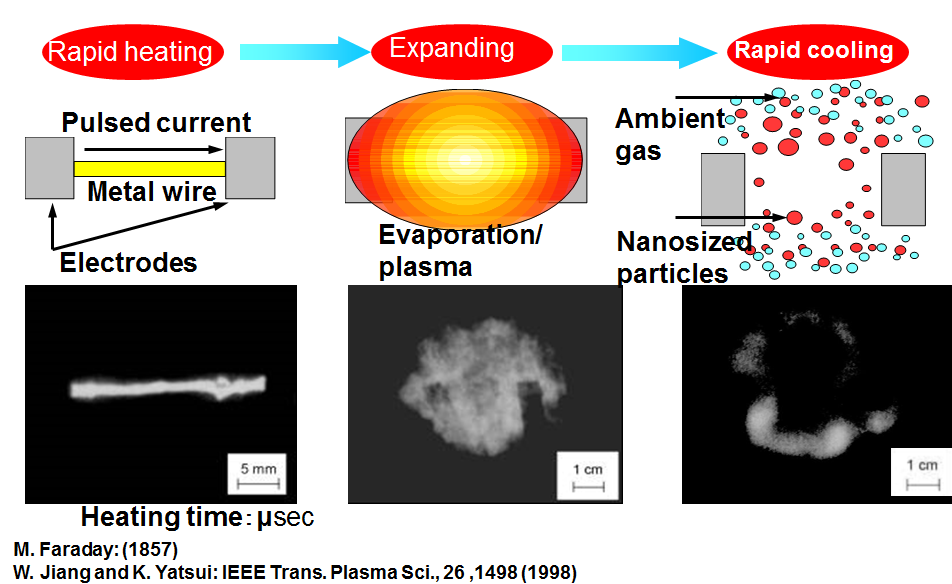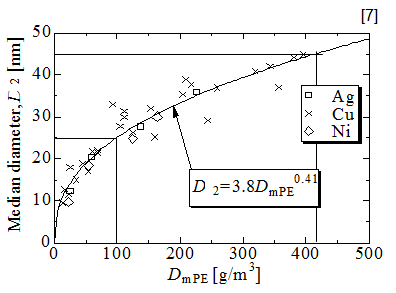Powder Production by Pulsed Wire Discharge
パルス細線放電による超微粒子作製

1) Pulsed Wire Discharge
Pulsed wire discharge (PWD) is a physical evaporation method to prepare nanosized powders. This method was originated from a electric wire evaporation method, which was developed by Faraday in 1857 and was direct heating of the wire by a pulsed large current. PWD is to make complete evaporation of wire by shortening the pulse width by circuit adjustment and utilizing arc discharge heating.
This method is characteristics of its high efficiency to convert energy and wide variety to chose wire species. By combination of wire and surrounding gas/liquid, various nanosized powders including metals, oxides, nitrides and carbides can be synthesized.
Massproduction apparatus was developed.
Collaborators: Indian Institute of Technology, Madras, Pusan National University, National Institute of Technology, Nagaoka Campus.
パルス細線放電
パルス細線放電は、1875年にファラデーによって開発された細線爆発法を基にした物理的蒸発による粒子作製法で、細線へ のパルス電流による直接通電加熱を特徴としています。回路最適化によるパルス幅短縮とアーク放電による加熱を利用し、完全な 細線の蒸発・凝結により、より小さな超微粒子を作製する方法です。
この方法は、高いエネルギー変換効率と、多くの細線を原料として使える特徴が有ります。細線とガス・液体の組み合わせによ り、金属、酸化物、窒化物、炭化物を作製できます。また、量産装置開発にも成功しました。
共同研究: インド工科大マドラス校、釜山大、長岡高専

2) Passivated Metal Particles by Organic Coatings
By PWD in inert gas with organic fume/vapor, we found that organic matter coated metal particles were formed. Oxidation was effectively suppressed by the organic coatings.
Using this method, various metal particles of Cu, Ti, Zr and Mg without oxidizing in air at room temperature were prepared.
有機物被覆された金属粒子作製
PWDを不活性ガスに有機物蒸気/霧を混合した中で行うことにより、我々は金属粒子表面に有機物を被覆する方法を開発しま した。これにより酸化が抑制されます。
Cu, Ti, ZrおよびMgなどの酸化しやすい金属粒子を室温大気中で酸化させずに作製することが可能です。
References:
Murai, et al., J. Ceram. Processing Res., 8 (2007) 114
Tokoi et al., Scripta Mater., 63 (2010) 9371
Tanaka, et al., Nanosci. Nanotechnol. Lett., 10 (2018) 858

3) Particle Size Control
Assuming the equation of state of ideal gas and Brownian motion, we have proposed a theory to predict the average particle size from the experimental conditions.
粒径制御
理想気体の状態方程式と粒子のブラウン運動を仮定し、平均粒径を実験条件から予測する理論を提案し、実験的に実証しまし た。
References:
Tokoi, et al., Jpn. J. Appl.Phys., 52 (2013) 055001
Sato et al., Jpn. J. Appl. Phys., 54 (2015) 045002
Nguyen et al., J. Appl. Phys., 130 (2021) 185901 (Editor's pick)